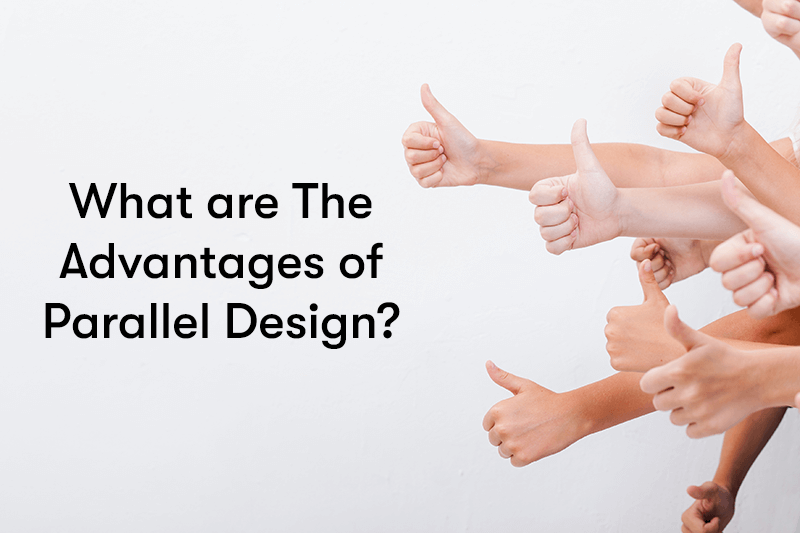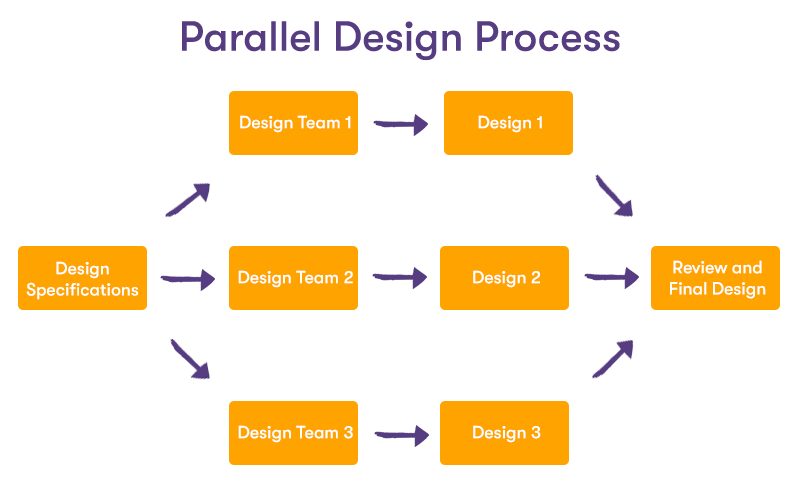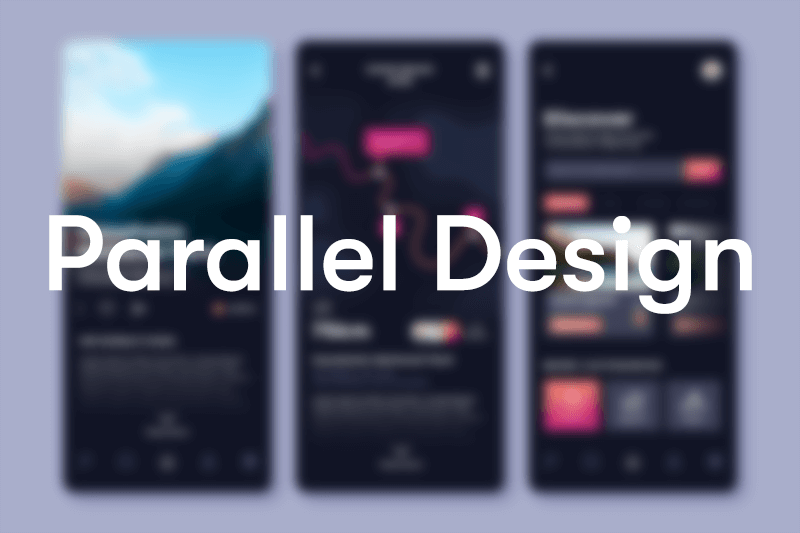Parallel Design
Parallel Design is a method that involves simultaneously developing multiple design alternatives. Discover the advantages of this approach, from fostering creativity and mitigating risks to enhancing user-centred solutions. We will also address the potential pitfalls and offer expert insights on navigating them effectively. Whether you're a UX designer, engineer, or simply curious about optimising your problem-solving process, this introduction to Parallel Design will equip you with the knowledge and strategies needed to harness its potential.
What is Parallel Design?
Parallel Design is a design process or approach in which multiple design solutions or ideas are developed simultaneously, often in parallel, and then compared, evaluated, and refined to determine the best solution. Parallel Design can be particularly useful when dealing with complex problems or uncertainty about the best solution.
It allows for a more robust exploration of design possibilities and can lead to more informed and successful design decisions. However, it's essential to manage the parallel design process effectively to ensure that it is manageable and results in decision paralysis and that it ultimately leads to a clear and well-executed final design.
What are The Advantages of Parallel Design?

Parallel Design offers several advantages in design and problem-solving. Here are some of the key benefits of using a parallel design approach:
Diverse Solutions
Parallel Design encourages the generation of multiple design alternatives or solutions. This diversity of ideas can lead to more creative, innovative, and unique outcomes.
Risk Mitigation
Parallel Design helps mitigate the risk of relying on a single solution by exploring multiple design paths simultaneously. If one approach encounters unexpected challenges or issues, there are alternative designs to fall back on.
Efficiency
While it may seem counterintuitive, Parallel Design can be more efficient in the long run. It can help identify potential flaws or limitations in a design early in the process, reducing the need for costly revisions or redesigns later.
Informed Decision-Making
Comparing and evaluating multiple design alternatives provides a more comprehensive understanding of the problem space and potential solutions. This leads to more informed decision-making and a higher likelihood of selecting the best-suited design.
Creativity and Innovation
Parallel Design encourages designers and teams to think outside the box and explore unconventional solutions. This can lead to breakthrough innovations that might have yet to emerge in a more linear design process.
User-Centred Design
When multiple design options are tested with users or stakeholders, it becomes easier to identify which design aligns best with user needs, preferences, and expectations. This supports user-centred design principles.
Flexibility
Parallel Design allows for flexibility in adapting to changing project requirements or constraints. If circumstances evolve, pivoting to a different design direction is easier.
Time Savings
While Parallel Design may require additional time upfront to explore multiple options, it can save time in the long run by avoiding costly design revisions and rework.
Improved Problem Understanding
Developing multiple designs deepens the designer's understanding of the problem space and the various factors influencing design decisions.
Collaboration and Teamwork
Parallel Design often involves collaboration among team members, fostering a collaborative and cross-functional approach to problem-solving and design.
Holistic Consideration
By considering multiple solutions, designers can take a more holistic view of the problem, taking into account various factors, such as usability, cost, aesthetics, and technical feasibility.
Quality Assurance
Comparing and evaluating designs can act as a quality assurance step, helping identify and address potential issues or oversights.
While Parallel Design offers many advantages, managing the process effectively is vital to avoid becoming overly complex or overwhelming. Careful planning, clear criteria for evaluation, and effective communication within the design team are essential to successfully harness Parallel Design's benefits.
What are The Disadvantages of Parallel Design?

While Parallel Design offers several advantages, it also comes with potential disadvantages and challenges that designers and teams should be aware of. These drawbacks can affect the effectiveness and efficiency of the design process if not managed appropriately. Here are some of the disadvantages of Parallel Design:
Resource Intensive
Developing multiple design alternatives simultaneously can be resource-intensive regarding time, effort, and costs. It may require a larger design team, more materials, and additional tools or software.
Complexity
Managing multiple design paths can become complex, especially when numerous alternatives are involved. This complexity can make it challenging to keep track of progress, feedback, and changes.
Decision Overload
Evaluating and comparing multiple design alternatives can lead to decision overload, where it becomes challenging to choose the best option. This can result in decision paralysis and delays.
Communication Challenges
Effective communication is crucial in Parallel Design to ensure team members are on the same page. Miscommunication or misunderstandings can lead to inconsistencies in design direction.
Conflict and Bias
Design teams may have differing opinions or biases when evaluating designs. Conflicts can arise when team members strongly favour one design over another, potentially hindering objective decision-making.
Reduced Focus
Working on multiple design alternatives can lead to reduced focus on individual design paths. Designers may spread themselves too thin, which can negatively impact the quality of each design.
Inefficient Use of Resources
If not managed carefully, Parallel Design can result in wasted resources on designs that are ultimately discarded. This can include time spent on developing concepts that are not selected.
Inconsistent Quality
Maintaining consistent quality across multiple design alternatives can be challenging. Some designs may receive more attention or refinement than others, leading to inconsistencies in quality.
Schedule Delays
If the evaluation and decision-making process takes longer than anticipated, it can lead to schedule delays in the overall project timeline.
Stakeholder Confusion
Stakeholders, including clients or end-users, may become confused or overwhelmed when presented with multiple design options. This can lead to difficulties in obtaining clear feedback.
Risk of Abandoning Good Ideas
When comparing and evaluating designs, there is a risk that a promising and innovative idea may be discarded prematurely.
Increased Management Complexity
Project managers and team leads may find it more challenging to oversee and coordinate parallel design efforts compared to a more linear design process.
To mitigate these disadvantages, it's essential to approach Parallel Design with a well-defined strategy and transparent criteria for evaluation. Effective communication and collaboration among team members are also essential to ensure the process remains organised and productive. Additionally, not every project may benefit from parallel design, so it's crucial to assess whether this approach is suitable for the specific design challenge at hand.
How to conduct Parallel Design?

Conducting Parallel Design involves developing multiple design alternatives simultaneously and comparing them to identify the most suitable solution. Here's a step-by-step guide on how to conduct Parallel Design effectively:
Define the Problem and Objectives
- Clearly articulate the design problem or challenge you're trying to address.
- Define specific objectives and goals for the design process. What do you want to achieve with the final design?
Assemble a Design Team
- Form a cross-functional team with members who bring different perspectives and skills.
- Ensure that team members understand the problem and objectives.
Generate Design Ideas
- Encourage brainstorming sessions to generate a wide range of design ideas and concepts.
- Allow team members to explore various approaches and solutions independently.
Create Design Alternatives
- Based on the brainstorming sessions, have team members develop multiple design alternatives. Each team member or sub-team should be responsible for one or more alternatives.
- These alternatives should differ in their approaches, concepts, or key design elements.
Set Evaluation Criteria
- Establish clear and objective criteria for evaluating the design alternatives. Common criteria may include usability, feasibility, cost-effectiveness, user satisfaction, and alignment with project goals.
Prototype and Develop Designs
- Create prototypes or design mock-ups for each alternative. Depending on the project's scope and resources, these can range from low-fidelity sketches to high-fidelity interactive prototypes.
User Testing and Feedback
- Conduct user testing and gather feedback on each design alternative. This can involve usability testing, surveys, or interviews with potential users or stakeholders.
- Collect qualitative and quantitative data to assess how well each design meets user needs and objectives.
Evaluate and Compare Designs
- Analyse the data collected from user testing and feedback. Evaluate each design alternative against the established criteria.
- Consider the strengths and weaknesses of each design in terms of usability, feasibility, and other relevant factors.
Select the Preferred Designs
- Identify one or more preferred design alternatives based on the evaluation and comparison. These designs best meet the project's objectives and user needs.
- Consider whether a hybrid or combination of elements from different designs could be the most effective solution.
Refinement and Iteration
- Refine the selected designs based on the feedback and insights gained during the evaluation process.
- Iterate on the chosen design to make improvements and address any identified issues.
Presentation and Communication
- Present the selected designs and the rationale behind your choices to stakeholders, clients, or team members.
- Communicate the benefits and trade-offs of the chosen designs.
Implementation and Development
- If the design will be implemented or developed further, collaborate with the appropriate teams or individuals to ensure a smooth transition from design to execution.
Documentation
- Document the design process, including the design alternatives, user feedback, and the final design decisions. This documentation can be valuable for future reference and as a learning resource.
Testing and Validation
- After implementation, continue to test and validate the chosen designs to ensure they meet the intended goals and objectives.
Iterate as Needed
- If necessary, iterate on the design based on user feedback and real-world usage to continuously improve.
Parallel Design can be a highly effective approach for solving complex problems and generating innovative solutions. However, it's essential to manage the process carefully, maintain clear communication within the team, and keep the focus on the user's needs and project objectives throughout the entire process.
Where can you learn more about UX Design?
Our BCS Foundation Certificate In User Experience training course is perfect for anyone who wants to increase their knowledge of User Experience. The BCS User Experience course will teach you the UX methodology, best practices, techniques, and a strategy for creating a successful user experience. The course will cover the following topics:
- Guiding Principles
- User Research
- Illustrating The Context Of Use
- Measuring Usability
- Information Architecture
- Interaction Design
- Visual Design
- User Interface Prototyping
- Usability Evaluation
Click the button below to find out more.

Final Notes on Parallel Design
In conclusion, Parallel Design is a strategic approach that offers both benefits and challenges in the realm of creative problem-solving and design. By simultaneously exploring multiple design alternatives, teams can harness the power of diverse ideas, mitigate risks, and achieve efficient solutions.
However, careful management, well-defined evaluation criteria, and effective communication are paramount to its success. Through this structured approach, designers and innovators can not only enhance creativity and innovation but also ensure that the chosen design aligns with user needs and project objectives.



